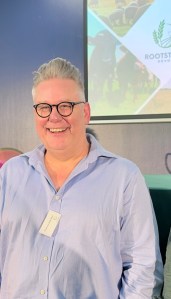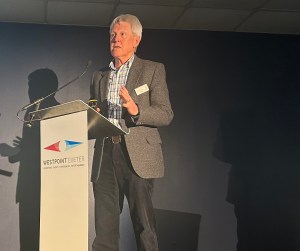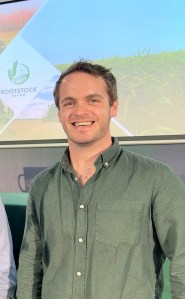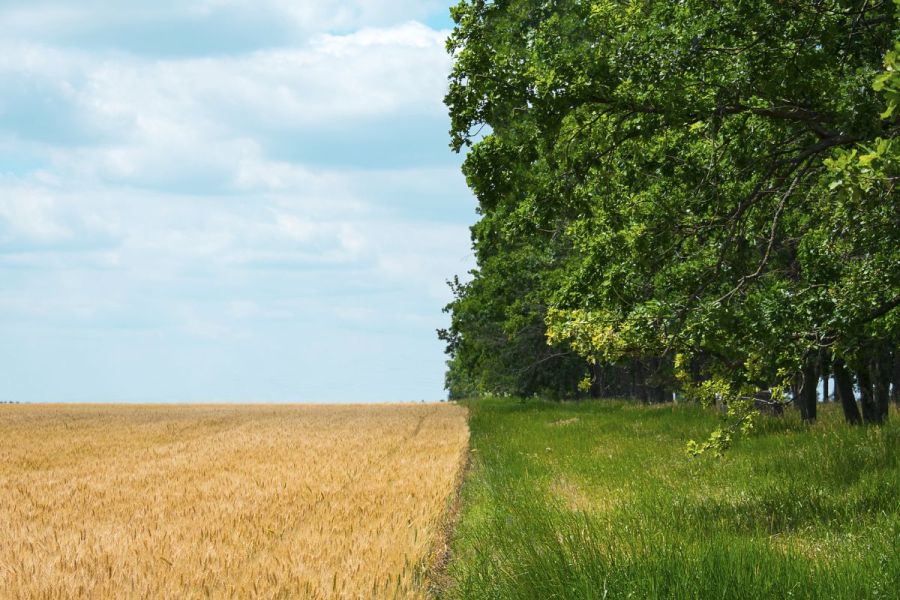Aiming to connect farming systems, soils, people and technology, the inaugural Rootstock event in early February took on an almighty task. CPM went along to find out more.
“There’s a lot of people itching to turn regen into fancy things to be ticked off on a clipboard.”
By Melanie Jenkins
Situated amid the rolling Devon hills near Exeter, the first Rootstock event was a total sell out, drawing in a crowd eager to learn more about resilient and profitable farming.

At the heart of building profitable, resilient farming for the future for both farmers and academics is soil and how it functions.
Leading proceedings, farmer and chairman of Adapt Biogas, Sir Harry Studholme claims that there’s no one way forward for farming. “Instead, there’s a journey to be made for farmers about how we build profitable, resilient farming for the future. But there’s also a journey being made parallel to this in the academic world, which is also trying to support these aims for a more viable future.”
But at the heart of the journey for both farmers and academics sits soil and how it functions. According to Professor Andy Neal of Rothamsted Research, soil is a dynamic process. “It’s not a static physical thing. The more we look at it, the more we realise it’s a living entity that responds to the way it’s managed and that it’s all about connectivity, in the same way that human society is all about connectivity – and with soil it’s particularly the connectivity of pore space. This is what allows the biology in the soil to flourish,” he explains.
“Connectivity is the basis of a healthy soil as this controls microbial metabolism,” says Andy. “We now have evidence that microbial metabolism evolves under the constraints imposed by connectivity between pores and this has a really important influence upon its nutrient use efficiency.”

Connectivity is the basis of healthy soil as this controls microbial metabolism, according to Andy Neal.
And this is shaping the way soils systems are identified, he says. “We are starting to think of soils as either adaptive or non-adaptive systems in regards to organic matter inputs. For example, sandy soils don’t really respond and don’t sequester much carbon, whereas silty clay loams do respond nicely and sequester a lot of carbon.”
In adaptive soils, those with low carbon have very little porosity or connectivity between the pores present, whereas those with high carbon have a lot of pore space and high connectivity between these, says Andy. “Dependent on how much organic matter is in the soil, the degree of connectivity follows a very predictable response. Understanding how systems behave from a connectivity point of view is extremely important.”
In permanent pasture there’s a lot of porosity and connectivity between those pores, but in low carbon soils typical of arable systems there are still pores but fewer of them and the connectivity is extremely reduced, he explains. “Those pores, which are about 100 microns or less in size, are the pores which hold water back by capillary action as the soil drains after a rain event. This space effectively represents the water holding capacity of the soil.
“Not only are high organic matter soils more connected and able to hold water, they also have a great ability to move water around and, more importantly, oxygen and nutrients,” says Andy. “In poor organic matter soils there are a lot of dead ends which makes moving anything extremely challenging. It’s a logistics issue.”

High organic matter soils are more connected and able to hold water, they also have a great ability to move water around.
Pore space also controls plant root access to water and by limiting oxygen diffusion through these systems, it creates very poor soil environments, explains Andy. “This results in anaerobic spaces which drives microbial activity into very negative behaviours which produce methane and nitrous oxide due to anaerobic respiration. Whereas in very highly connected systems, there isn’t that increase in metabolic pathways.
“So we have this pore space controlling the way the physics of the soil works, which directly influences the microbial genetic component, and that component evolves to suit the new physical construction,” he surmises. “You can drive this in a positive way by adding organic matter to adaptive soil, where you get much greater pore space and connectivity. And in more connected pore spaces, we see increased nutrient use efficiency because we’re losing less nitrous oxide from these soils that have a lot more oxygen in them.”
And when soils are cultivated, their fabric is broken up into aggregates, adds Professor John Crawford of the University of Glasgow. “Soil is an adaptive system and is always adapting to the prevailing system and that is largely down to the energy flowing into it.
“Think of soil like a battery. It needs physical and biological power in order to function. When you’re tilling, you’re breaking up the structure and letting oxygen in, enabling the microbes to burn carbon faster. Whereas if you just left soil naturally, it burns off carbon more slowly and keeps it in the soil,” he adds.
But understanding the functionality of soil through science is just one way in which academics are helping drive the future of farming.

Engagement between the research and agricultural community is really important.
According to Professor Will Blake of the University of Plymouth, a lot of the answers to his research questions have been found within the agricultural community. “So the engagement between the research and agricultural community is really important and getting that steer to make our research relevant to the real world is absolutely fundamental.
“There’s innovation happening at farm scale to enhance soil carbon management and to mitigate climate change, as well as to provide the added values of soil health productivity.”
Will’s colleague, Professor Mick Fuller, explored some of the technological advancements bringing science and agriculture together.
“One of the big things that’s held back the application of robotics in agriculture is the fact we have this chaotic, unpredictable environment,” he says. “The weather, topography and soil type all change.”

The next challenge for researchers is now not just to develop technology, but to value engineer it, says Professor Mick Fuller.
This means it’s not been as simple as taking robotics used in industry and putting these onto farms. “The robots in industry are very precise and are known as hard robots. The trouble with hard robots is that they can only put something into a single space, and that space has to be the same every time,” explains Mick.
But some of the robots developed at the University of Plymouth have overcome this challenge and are now actually working in the agricultural landscape.
The first company Mick highlights is Robotriks. “This is an agricultural robotics platform that has taken on earlier research from other platforms developed elsewhere in the country which effectively didn’t work,” he explains. “Either because they were too heavy, too cumbersome or because the robots couldn’t find their way around a field.”
But the team of researchers has managed to build lightweight platforms with incredible power and stable framework to which sensors and robotic arms can be attached, says Mick. “We have tested these over and over in the field. The important thing is getting it to work in the field and then to value engineer it – making it affordable.
“This small but powerful unit can traverse a field and we’ve used it in Devon and Cornwall on hilly and flat ground and it performs equally well on both. The robot knows its exact location and where it’s going through precise GPS navigation. It also has a powerful battery system so it can keep going for 24 hours,” he explains.
“That’s the beauty of all these robotics – it’s not that you’ve got to stand there and watch it, you can set it going and trust the technology, then come back hours later and the robot will have completed its task.”
Another company, Fieldwork Robotics, has focused on creating what’s known as soft robotics. “The real innovative part of this platform is that it doesn’t have to work with a precise thing in a precise location every time. For example, if the arm of the robot gets bashed by something, it can reposition itself and knows its exact location,” explains Mick. “These robots have so many sensors and such soft dynamics that they can negotiate the unpredictable agricultural landscape.”
The other area of technology applied to agriculture which is advancing at pace is space technology, he says. “The Agri Living Lab is endeavouring to harness the data that comes out of satellites and put this into a system that can assist with management on farm. It’s really multi-faceted.”
The project has been coupled with another University of Plymouth venture; a mobile lab. “This is set up in a little horsebox that can be towed to a field,” explains Mick. “But packed inside it are all the sensors and testing kits to analyse the soil in the field at the point of sample. This is proving to be really interesting from the perspective of setting up a service for farmers. Some of the sensors are so sensitive we don’t quite know what they mean yet and we’re still trying to interpret the data they’re generating.”
Then there’s diagnostics and DNA applied science, coupled with some light imaging technology that’s able to detect diseases, he says. “This has become so much more sophisticated, meaning fungal infestations can be both detected and characterised more easily and accurately.
“Our challenge now is not just to develop technology, but to value engineer it – bringing the cost down without losing any efficiency or robustness,” adds Mick. “If we can value engineer technology, then it becomes affordable for everybody.”
What is regen?
What is regenerative agriculture? This might seem like a ridiculous question given the mass of interest, discussion, media hype and marketing surrounding it, but the three farmers on the discussion panel at Rootstock expressed very different views on it.
For John Cherry, a Hertfordshire farmer of Groundswell fame, regen agriculture is not just a fancy term but a direction of travel. “Once you’ve seen the light, you change what you’re doing to try to make things better. There’s a lot of people itching to turn regen into fancy things to be ticked off on a clipboard so they can charge more for what they produce. But to me, I just want to make my farm better. It would be very nice if someone wanted to pay me extra for it, but either way it’s improving my farm and I can make more money as it’s a cheaper system.”

For James Lee, regen is about tweaking around the edges and having a play with things.
James Lee, of Uppincott Farm in Devon, sees direct drilling systems as a solution to soil erosion on his hilly land. “Over the past 20 years we’ve come to appreciate direct drilling, not just as a system, but for enhancing the biological processes of the soil and how it can reduce our costs.
“For me, regen is about tweaking around the edges and having a play with things. It’s working out the systems to get the best results for you,” he adds.

Ed Horton, who runs a mixed farming operation in the Cotswolds, doesn’t like the word regen at all.
Whereas Ed Horton, who runs a mixed farming operation in the Cotswolds, doesn’t like the word regen at all. Instead, he operates what he calls a ‘hybrid system’ which aims to integrate different farming practices and reduce risks in the challenging environment of having what he says is “no soil” on his land. “Our soils don’t hold water and our elevation means we are often above the rain. We redesigned our farming system to integrate what we have at our fingertips, which includes a lot of livestock.
“But I don’t like the word regen because it can mean anything to anyone – which in some respects is wonderful,” he admits. “But as you can apply it to so many things, in another respect it’s actually lost its core meaning. I do farm like John, but I also have a large plough. I feel labelling can lead you down a path of being too restrictive.”
For all three farmers, reducing soil disturbance, incorporating cover crops and utilising livestock are core elements of their systems, so in many respects they agreed on practices but each tailor them to their own farms. For example, Ed uses his flock of sheep to hard graze his cereal crops, but James feeds his with oat and bean cover crops during the winter.
When asked about animal health, Ed detailed how his grazing rotation of 10 consecutive days in a year and use of chicory leys minimises the requirement for worming.
And John claimed he has to practically explain to the vet who he is each time he rings as it’s so infrequent. “We move our cows every day and if you watch them, they self-medicate when grazing. When I’m asked what my herd health plan is, I say my plan is to have healthy animals. Health is the very basis of everything that regenerative farming is all about.”
This article was taken from the latest issue of CPM. For more articles like this, subscribe here.
Sign up for Crop Production Magazine’s FREE e-newsletter here.




